Content
Downloads
Shaping a Strong Learning Culture
Overview
The learning culture at Learnlife is purpose-driven to enable individuals to discover their unique passions. Learnlife digresses from content-driven learning, where learners are conditioned by knowledge bestowed onto them by the decisions of others. The learning community places responsibility on the learner to shape their own purpose while learning guides assist through mentorship and facilitation. Understanding that a culture of learning can (and should) be grown and shaped, is central to creating the right dynamics for deep, passionate, purpose-inspired learning.
In a global society, where young people are exposed to and influenced by media-oriented western culture, there is a strong imperative to create a learning culture that is equal to or stronger than other existing cultures that influence. The Learnlife model aims to inspire individuals to recognise learning as positive and include it in their lifelong journey. Learning culture and vision therefore must be shaped so it becomes as attractive as other presenting cultures for any individual.
Executive Summary
For a strong learning culture to emerge, it must be appealing to the learners who form that community. This requires offering learning that is suited to the 21st century.
Education should draw inspiration from an emerging on-demand, global culture; content in an on-demand learning context must become bespoke to suit every individual. Making learning personal enables students to decide on their own vision for success, letting them control the content they wish to engage with, while offering continued guidance and support.
To succeed in the 21st century, learning must become a lifelong pursuit, and learning communities must provide opportunities for students to cultivate the skills required to enable continued learning beyond its influence. The overarching mission for any learning community should therefore be to move students towards greater independence and interdependence so they manage their own learning. Education systems until now have largely been about managing students and learning, so there is a great deal of unlearning and relearning required if lifelong learning is the goal.
Some members of a learning community will use their own experiences as the default position when it comes to thinking about learning. If those people have only experienced traditional education models where the teacher was positioned as a provider of knowledge and the student like an empty glass to be ‘filled up’, there is considerable work to be done. One of the crucial elements to shaping a strong learning culture is that the community should always suit each learner, not the other way round.
A learning community must seek input from educators, parents, and students to guide the type of learning culture they wish to create. Learning must be recognised as a positive process, and one of the most important ways to do this is to include learners in the process of envisioning the type of learning culture that can help them to thrive in their community. Changing attitudes and assumptions on what learning is and should be is crucial for success and a sure step to providing unique and relevant experiences for all.
Shaping a strong learning culture is an iterative process and something that requires continued envisioning and evaluation to succeed; the work is never done. Embracing a growth mindset within the community is vital to encourage and foster the type of mindsets willing to fail in order to find the solutions that suit their context.
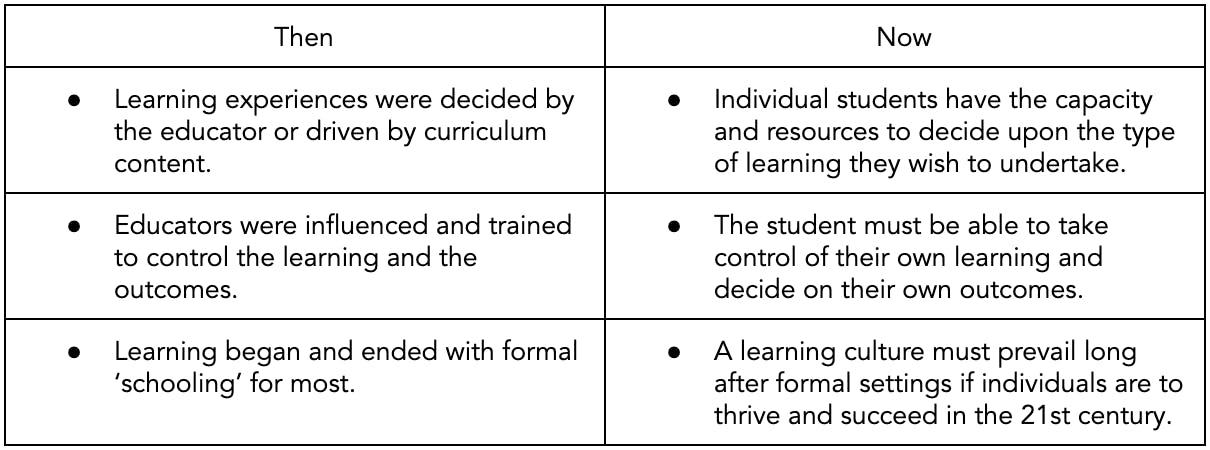
Starting Questions
- Does your learning community control all the learning outcomes or give agency to each individual student to decide on their own outcomes?
- Are all the key actors in your learning community involved in the envisioning process that shapes the overall learning community culture?
- How much emphasis do you place on planning learning experiences in your community’s learning culture? And are the students part of this process?
- Have you or your learning community considered the learning capacity and skills of your students once they leave your setting? Are they equipped to guide their own learning?
- Do the learning experiences in your community offer opportunities for transdisciplinary or multidisciplinary learning?
Key Initial Actions
- Invite people to join an envisioning team to analyse and shape learning culture. This should link to the learning community mission and importantly shape pedagogy.
- Go deep into the concept of culture in connection with educational change. Gather key information through research that can be shared with the whole community and support shaping culture. Observing other organisations should be included.
- Create statements that capture the desired learning culture for your community. This should include key actors representing all departments.
- Conduct a community survey with all key actors to gather perceptions of the current learning culture.
On-going Actions
- Revisit the learning statement regularly with your envisioning team and inform the whole community when changes occur. Be willing to do this regularly.
- Ensure short, medium and long term broad strategy plans are devised and utilised to stay on target to shape the desired learning culture for your community.
- Micro-plans should be drawn up from broad strategy plans that are relevant to various activity spheres that can support the overall culture statement and help it grow.
- Continually assess and evaluate whether every individual across all departments in the learning community is represented by the envisioning statement.
Find out more
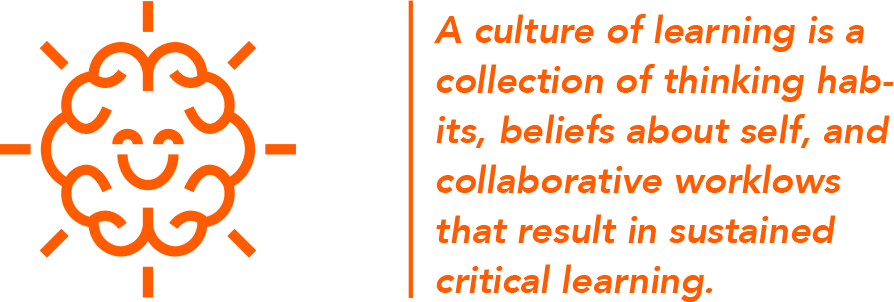
This element is about growing and shaping a positive cultural mindset with respect to learning. It provides information about shaping the learning culture of an organisation in positive ways, so that the community embraces learning as an on-going pattern in life. It outlines tools and strategies useful in assessing the existing culture of learning and provides examples where initiatives have strengthened learning cultures.
Key Ideas
- Learners thrive where there is an accepted assumption that learning is a lifelong, positive process.
- There is a need to shape a learning culture so it enables positive growth in every part of the community.
- For the right type of learning culture to emerge that is relevant for the 21st century, a lot of unlearning and relearning is required.
- Understanding mindsets and assumptions of the key players in a learning community is critical to influencing and shaping the correct type of culture.
- Shaping a strong learning culture must be done in collaboration, with all key players involved in that process.
Questions
- How can a learning community create a learning culture that continues to influence its students long after they leave?
- What type of professional development should a learning community undergo to develop their capacity to design and implement a strong learning culture?
- How might a learning community set itself up so a strong learning culture emerges to include every student?
- What are the community viewpoints and assumptions on learning, schools and education?
- How much emphasis is placed on considering the underlying values and assumptions of all key actors in a learning community?
1. Learners thrive where there is an accepted assumption that learning is a lifelong, positive process.
When considering how to best establish a strong community where learners and learning thrives, it is important to understand the critical importance of a well-established and self-perpetuating positive culture of learning. If educational innovation or transformation is undertaken in a context where the culture does not support such vision, then those innovations or transformations will likely struggle to sustain.
A positive culture of learning needs to support deep and enduring patterns of lifelong learning. For teaching practices to change and better support deep and enduring lifelong learning, there needs to be clarity around the culture, practices and mindsets of the whole community.
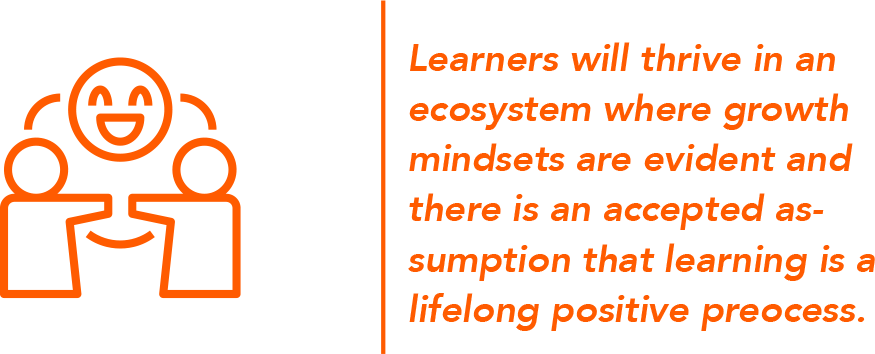
2. There is a need to shape a learning culture so it enables positive growth in every part of the community.
A culture that seeks to empower independent and interdependent learning is the goal. This is best done when supported by fostering the growth mindsets of all key players in the learning community (see element 5).
Many players within a community have been conditioned to be more passive recipients in the learning process, with an effective dependency on those who they see as setting the rules or providing the content. Moving learners towards greater independence and interdependence can create the right type of learning culture that can promote the positive patterns of lifelong learning. Extending beyond its students, all other key players play a crucial role and must be included in the process of shaping a strong learning culture.
3. For the right type of learning culture to emerge that is relevant for the 21st century, a lot of unlearning and relearning is required.
Some members of a community will use their own learning experiences as the default position when it comes to thinking about learning. If those people have only experienced a traditional education where the teacher was positioned as a provider of knowledge and the student like an empty glass to be ‘filled up’, then there is considerable work to be done to prepare a community that better understands the future directions of the workforce and the known and likely impact of advances in technology on jobs and careers.
The challenge is to create a learning culture that empowers its students to self-determine their own learning. For that to occur, all members of the learning community must work toward this common goal. Given that school systems until now have largely been about managing students and learning, there is a great deal of unlearning and relearning required if self-determined learning is the goal.
An additional challenge is to move the focus of learning away from purely being about content and knowledge – particularly content that is rote learnt and repeated in examination contexts. The focus of cultural shift needs to be towards empowering the learner through developing their understanding of how they learn and how they can continue to grow. Once a learner grasps the notion of growing independently and using their own strategies, they will be better placed to continue as lifelong learners.

4. Understanding mindsets and assumptions of the key players in a learning community is critical to influencing and shaping the correct type of learning culture.
To shape the learning culture, specific analysis could be undertaken of these four groups, including:
- Learner attitudes and assumptions about learning:
Are the students expecting learning to come from what someone else teaches them or do they see their role as an active learner drawing from multiple people and sources? - Parent attitudes and assumptions about learning:
Do parents hold perspectives on learning that might support deep learning? Do their assumptions about learning illuminate any need to shape their expectations or understandings? - Teacher mindsets and beliefs about learning:
Do teachers hold perspectives that may need to be challenged? Do they adhere to a control mindset or an empowerment mindset when it comes to causing learning? (Refer to Element 9: Personal Learning and Adaptive Groupings) - Community viewpoints on learning, schools and education:
What is the wider community culture with regards to learning? What is valued – outcomes or process? What messages are conveyed by the predominant media?
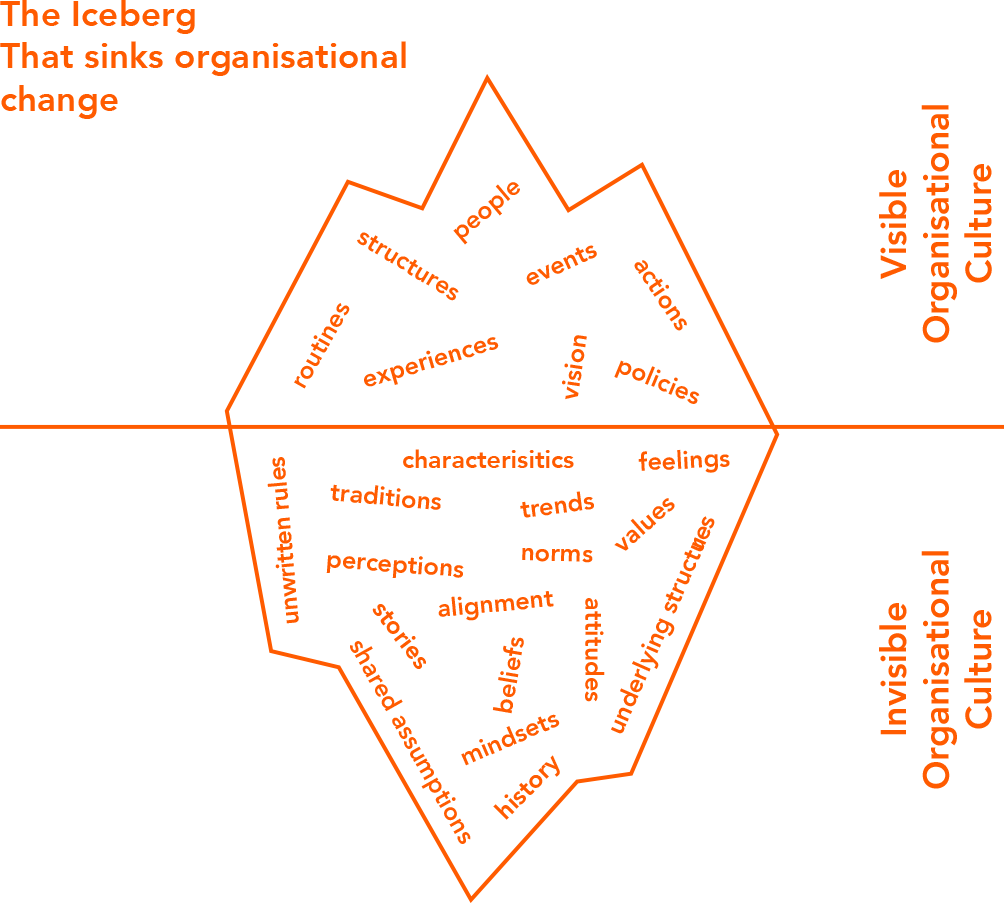
5. Shaping a strong learning culture must be done in collaboration, with all key players involved in that process.
The imperative to shape a positive culture of learning within an organisation is foundational to facilitating more pervasive change. It does not happen overnight and it is vitally important that all parties are engaged in the process. Establishing a strong learning culture should be a collective task with the expectation that all members of the community join in. Deep and embedded learning will not sustain in an environment where independent learning is not the pervasive pedagogic goal.
Act now
There are logical steps that should be taken if there is a collective desire to identify the existing mindsets and cultural predispositions. Once this is achieved, it is time to act to grow or strengthen a positive learning culture where the desire to learn is the immediate, prevalent and predominant thought.
1. Learn, connect & align with the module purpose
The learning culture of an organisation refers to both the visible and the invisible aspects of the organisation. It is its essential DNA. Change agents need to be very clear about the culture in which they work, especially if they seek to shape it in fresh directions.
If seeking to catalyse educational change, it is critical to understand the role that learning culture plays in a learning community before creating any broad ranging program. The guiding team who seek to shape or strengthen the organisational culture need to not only gain a passion for the task, but be deeply connected to the process. Culture shaping takes time, energy and commitment. The guiding team needs to be totally aligned in terms of the process, objective and strategies. There are a range of ways that this might be achieved.
The following list is suggestive, not exhaustive:
- Allow time to ‘go deep’ into the concept of culture in connection with educational change.
- Invite people to join an envisioning team to kickstart learning culture analysis and subsequent shaping activities.
- Observe other organisations to develop the capacity to analyse culture in different contexts.
- Create statements which capture a desired learning culture and communicate this with strength and clarity to the community.
- Recognise elements that work against a common preferred learning culture and tactfully raise expectations that everyone should be aligned to a process that seeks to shape it.
- Conduct a survey that explicitly seeks to gather perceptions of the culture of learning. (How do learners (students) feel about learning in the institution? How do students feel about their educators? Do people feel recognised and welcome in the community? How is this expressed?)
- Gain input from all stakeholders so that any statement about the desired culture of learning is genuinely reflective of the whole community.
Activities that aim to strengthen the culture of learning are a valuable investment - without a clear culture supporting passionate learning, the impact of any strategies will be limited. Strategic actions related to this do not need to have a high cost, they are more to do with understanding and shaping community mindsets. The impact of any development in this area is very significant and potentially foundational for all other strategies.

An investment in developing the right learning culture for an organisation will have a long-term, positive impact. Strategic activities could be as simple as minor additions to the routines of the day that demonstrate that people are valued. It might also include intensifying the visibility of learning across the community. The monetary investment does not have to be high. The investment in valuing people is critical. High impact with potentially low investment.
Definitions of a culture of learning
One definition of culture asserts that it is ‘the dominant values and beliefs that influence decision-making … culture is a critical component of any learning environment. It is important to be aware of the influence of culture within any particular learning context, and to try and shape that culture as much as possible towards supporting the kind of learning environment that you believe will be most effective.’
2. Analyse your context, identify needs & do research
The process of creating a strategy to strengthen the culture of learning requires accurate insights into the existing learning culture.
Create a database of images and reflections, built up over a period of time and utilising the perspectives of as many different people as possible. Facilitate a group process that looks at the images and reflections from as many different perspectives relevant to different sections of the wider community. Analyse and comment on the cultural implications from these different perspectives.
Other ideas to help analyse your context might include actions such as:
- Organising guided group conversations around participant experiences of learning.
- Conducting a survey that targets specific responses about mindsets toward learning.
- Undertaking regular observation ‘walks’ and progressive recording of insights.
- Gaining spontaneous verbal feedback from all sections of a community.
- Conducting random checkpoint visits around the school/organisation, taking note of the type of learning visible, the physical components of the environment and the nature and quality of relationships within the space.
- Organise ideation sessions and aim to implement as many ideas in a short period of time and assess what has an obvious positive impact.
- Select the terminology of learning that would be helpful in shaping culture; promote the use of that terminology consistently across the whole organisation.
- Hold high expectations that everyone will be a positive contributor to the shaping and strengthening of a learning culture.
- Share images and reflections with a wider group and invite constructive feedback.
- Be careful to not ‘name and shame’ any individuals in the process. Strive for a neutral perspective in an analytical process.
- Map existing and desired target culture.
Any desire to transform a model of learning is contingent upon having the right culture to support the learning. There are multiple cultures within a community that need to be considered and shaped to better support and strengthen a positive learning culture.
Create a version of a continuum such as that illustrated above, relevant to the context of your school, institution or organisation. Map the existing culture, as it is perceived. Select a desired target for the learning culture per element by allocating a position on the continuum for each listed component. Add other components as relevant and apportion responsibility. Use the map as a guide and reference tool.
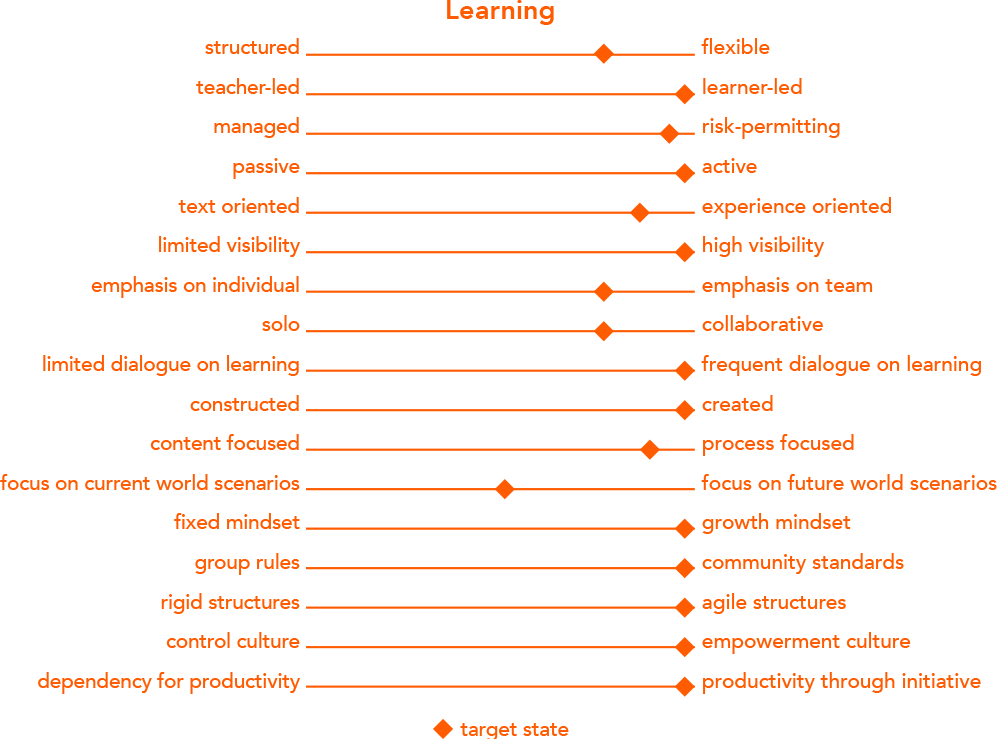
Specific analysis should be undertaken of these four groups, including:
- The existing attitudes and assumptions about learning within the learners.
Are the students expecting learning to come from what someone else teaches them or do they see their role as an active learner drawing from multiple people and sources? - Parent attitudes and assumptions about learning.
Do parents hold perspectives on learning that might support deep learning? Do their assumptions about learning illuminate any need to shape their expectations or understandings? - Teacher mindsets and beliefs about learning.
Do teachers hold perspectives that may need to be challenged? Do they adhere to a control mindset or an empowerment mindset when it comes to causing learning? (Refer to Element 9:Personal Learning & Adaptive Grouping) - Community viewpoints on learning, schools and education.
What is the wider community culture with regards to learning? What is valued – outcomes or process? What messages are conveyed by the predominant media?
3. Articulate goals and define measurable objectives
The third step in developing the right culture of learning is key. The simplicity, clarity and strength of articulated goals will set the focus and pathway for the actions that will help shape the desired culture and align the whole community. The messaging around the desired culture of learning creates the pedagogic vision that will help steer all actions. Set goals around this vision to create focus.
A common framework used for goal setting in both individual and organisational contexts is the SMART criteria: Goals should be specific, measurable, attainable, relevant and timely. In an organisational context, it is also important that articulated goals are both known and actionable by everyone. In relation to establishing or strengthening a learning culture, the goals should be highly aspirational in order to drive and steer the wider community forwards toward the goal.
Momentum is generated when there is clarity and alignment around goals. However, goal setting is not a one-off exercise – goals can be constantly refined, rephrased, re-communicated. Once the desired culture starts to establish, then greater goals can be set and the momentum across the whole community drives the vision for a strong and positive culture of learning forward.
Success in establishing the desired learning culture can become more evident when a tipping point occurs. Such points are often only recognisable via retrospective reflection. If it becomes clear that the desired culture of learning has become, or is quickly becoming, the predominant culture across the organisation and for individuals, then the process of establishing a conducive environment for learning is clearly under way.
It is important to remember that not all individuals will live out the culture at the same speed, in the same way or with the same conviction. However, as momentum increases and the learning culture is embedded, community expectations will be more obvious and the expectations will help shape and identify the desired culture for individual learners.
Further following may be useful in planning to create some SMART goals:
- The Essential Guide to Writing S.M.A.R.T. Goals
- How to Set SMART Goals: A Goal-Setting Process to Achieve Your Dreams
The following article provides some cautions about using SMART goals. The cautions outlined seem valuable with respect to not expecting SMART goals to be the key answer to the challenge: - 3 Popular Goal-Setting Techniques Managers Should Avoid
4. Create a strategy; develop tactics & establish an action plan
Step 4 is about developing the broad strategy, the tactics to support that strategy and the actions required to implement the plan.
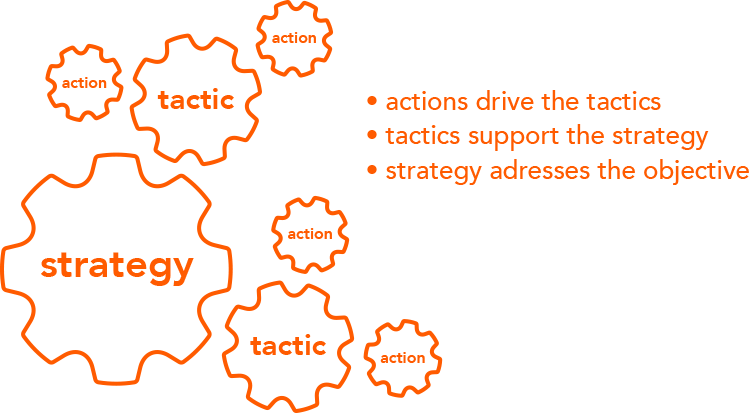
A useful illustration
The journey (and challenge) to become an elite sportsperson in a specific field provides a helpful metaphor when considering the connection between goals, strategies, tactics and action. A top-level sports-person may set a personal goal to improve their rank in the sport or perhaps be offered a position in a representative team. This requires a long-term strategy involving intensive training to achieve peak fitness, as well as preparing mentally for the challenge. It is likely that a coach will be engaged, along with other professionals to support the goal.
The strategy will be tested when it comes to a particular game or match. The long-term preparation and coaching is critical, but so too is an understanding of the other player or team. Targeted tactics during the game will perhaps exploit known weaknesses or simply ratchet up the pressure on the other side. The tactics might vary from game to game, match to match, as they will be sculpted to the immediate context. During the game or match, the actions and choices of the player or team will provide the momentum to drive the challenge forward.
Putting Strategy, Tactics and Action into practice:
When it comes to defining and shaping a stronger culture of learning within an organisation, the process could mirror that of a sportsperson.
- A goal should be set, perhaps through a collective envisioning process.
- A broad strategy should be developed utilising the passion and focus of those willing to step into proactive leadership. The strategy should outline the long-term plans.
- Different sections of an organisation might then take the broad plans and create a micro plan, relevant to their sphere of activity and in so doing, the vision grows.
- The smaller teams will develop the tactics that will help provide the momentum and shape the learning culture.
- Lastly, it is the actions of every person that will give energy to the tactics.
Final Word
As stated at the outset of this element, the imperative to shape a positive culture of learning within an organisation is foundational to facilitating more pervasive change. It does not happen overnight and it is vitally important that all parties are engaged in the process. Establishing a strong culture of learning should be a collective task with an expectation that all members of the community join in. Deep and embedded learning will not sustain in an environment where independent learning is not the pervasive pedagogic goal.
Examples in action
The listed schools would be noted as schools where there is a discernible and positive culture of learning. Students in these schools demonstrate a mindset that views learning as the reason for personal growth.
- XP School, Doncaster, United Kingdom
XP School has very consistent aims for every student and uses a consistent language about learning. There is a focus on character growth, resilience, kindness and deep learning that can be evidenced in the relationships across the school and the resultant strong sense of a caring and encouraging community. Among a range of approaches, XP School emphasises that:
- Everyone is a learner
- Design processes are important to make learning personal
- Character values must be lived
- Allocating regular time to community development is important
- Stonefields School, Auckland, New Zealand
Stonefields School has established a very visible culture of learning. Among a range of strategies, this is achieved through:
- Placing learning as the stated core business
- A consistency in the language used about learning
- Consistent signage and positive messaging about learning in every learning space
- Intentional preferencing of time allocated to professional pedagogic development
- High expectations of students that they will be both independent and interdependent in their learning, supported by protocols in problem solving consistent across the whole school
Further reading
Special thanks to the following co-creators:
Stephen Harris
Co-Founder & Chief Learning Officer
Bryan Gibson
Research and Paradigm Design
